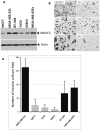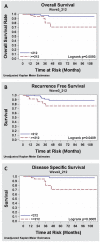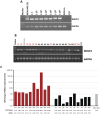Increased expression levels of WAVE3 are associated with the progression and metastasis of triple negative breast cancer
- PMID: 22952619
- PMCID: PMC3428347
- DOI: 10.1371/journal.pone.0042895
Increased expression levels of WAVE3 are associated with the progression and metastasis of triple negative breast cancer
Abstract
Background: Breast Cancer (BC) is a heterogeneous disease comprised of at least five genetically distinct subtypes, which together form the second leading cause of cancer death in women in the United States. Within BC subtypes, those classified as Triple Negative BCs (TNBCs) exhibit dismal survival rates due to their propensity to develop distant metastases. We have identified the WAVE3 protein, which is a critical regulator of actin cytoskeleton dynamics that are required for the motility and invasion of cancer cells through its activation of the Arp2/3 complex, as a key regulator of the different steps of the invasion-metastasis cascade in BC, especially in the more aggressive TNBCs. Our published studies have also shown that elevated expression levels of WAVE3 in the TNBC cell lines directly contribute to their increased invasion and metastasis potentials both in vitro and in vivo in murine models of BC metastasis.
Methodology/principal findings: Herein, we utilized both immunohistochemistry (IHC) of primary human BC tumors as well as quantitative real-time RT-PCR of WAVE3 in the peripheral blood of BC patients to clearly establish that WAVE3 is a predictive marker of overall BC patients' survival. High levels of WAVE3 were predictive for reduced distant recurrence-free survival as well as for decreased disease-specific mortality. Our analysis of WAVE3 expression levels in the peripheral blood of BC patients showed that WAVE3 is highly expressed in the blood of patients who developed metastatic breast cancer compared to those who did not. WAVE3 expression was also highly upregulated in the blood of BC patients with the more aggressive TNBC subtype.
Conclusions: Together, these findings establish WAVE3 as a novel marker for increased risk of breast-cancer-specific mortality and for the metastatic potential of the TNBCs, and also identify WAVE3 as an attractive therapeutic target for the treatment of metastatic BC.
Conflict of interest statement
Figures







References
-
- Jemal A, Siegel R, Xu J, Ward E (2010) Cancer statistics, 2010. CA Cancer J Clin 60: 277–300 doi: 10.3322/caac.20073. - PubMed
-
- Perou CM, Sorlie T, Eisen MB, van de Rijn M, Jeffrey SS, et al. (2000) Molecular portraits of human breast tumours. Nature 406: 747–752 doi: 10.1038/35021093. - PubMed
-
- Berx G, Raspe E, Christofori G, Thiery JP, Sleeman JP (2007) Pre-EMTing metastasis? Recapitulation of morphogenetic processes in cancer. Clin Exp Metastasis 24: 587–597 doi: 10.1007/s10585-007-9114-6. - PubMed
Publication types
MeSH terms
Substances
Grants and funding
LinkOut - more resources
Full Text Sources
Medical

